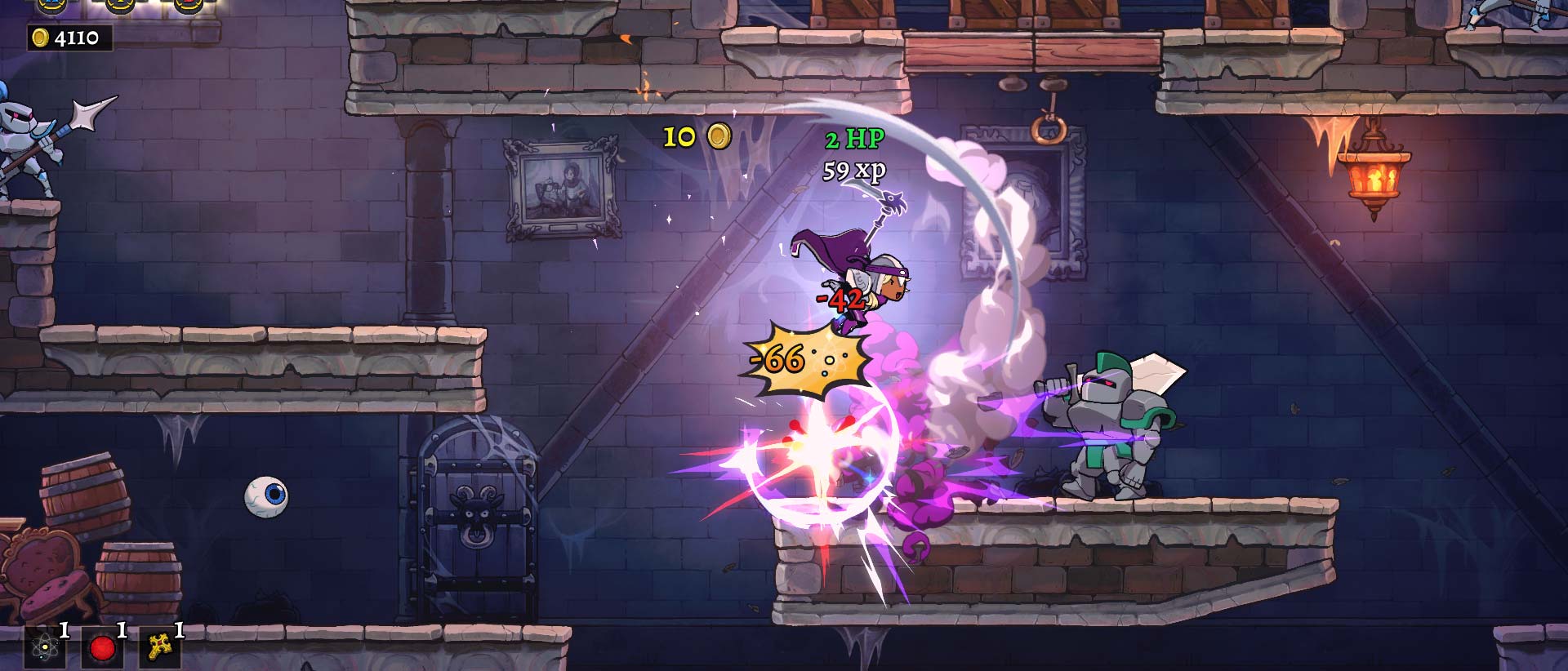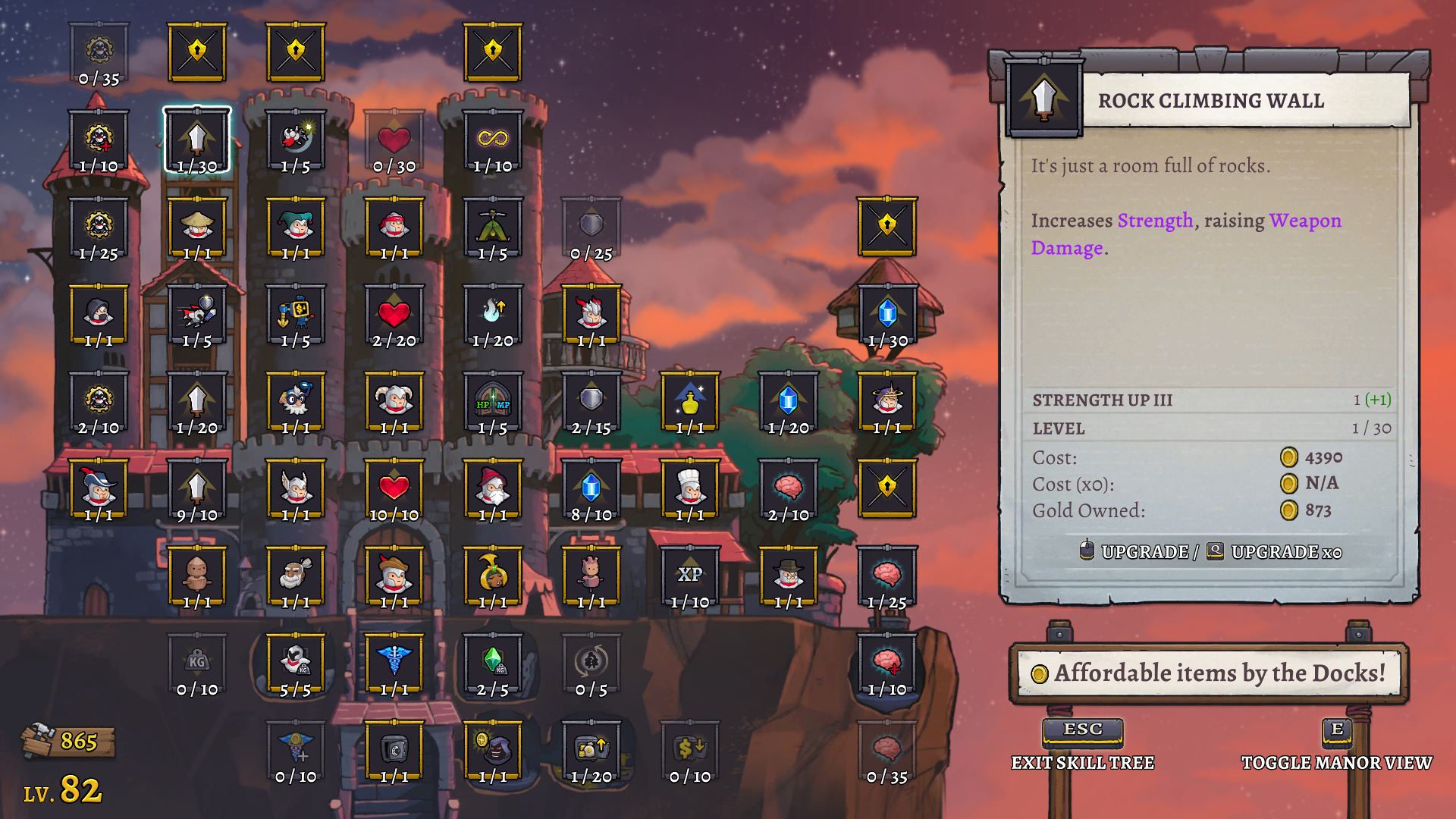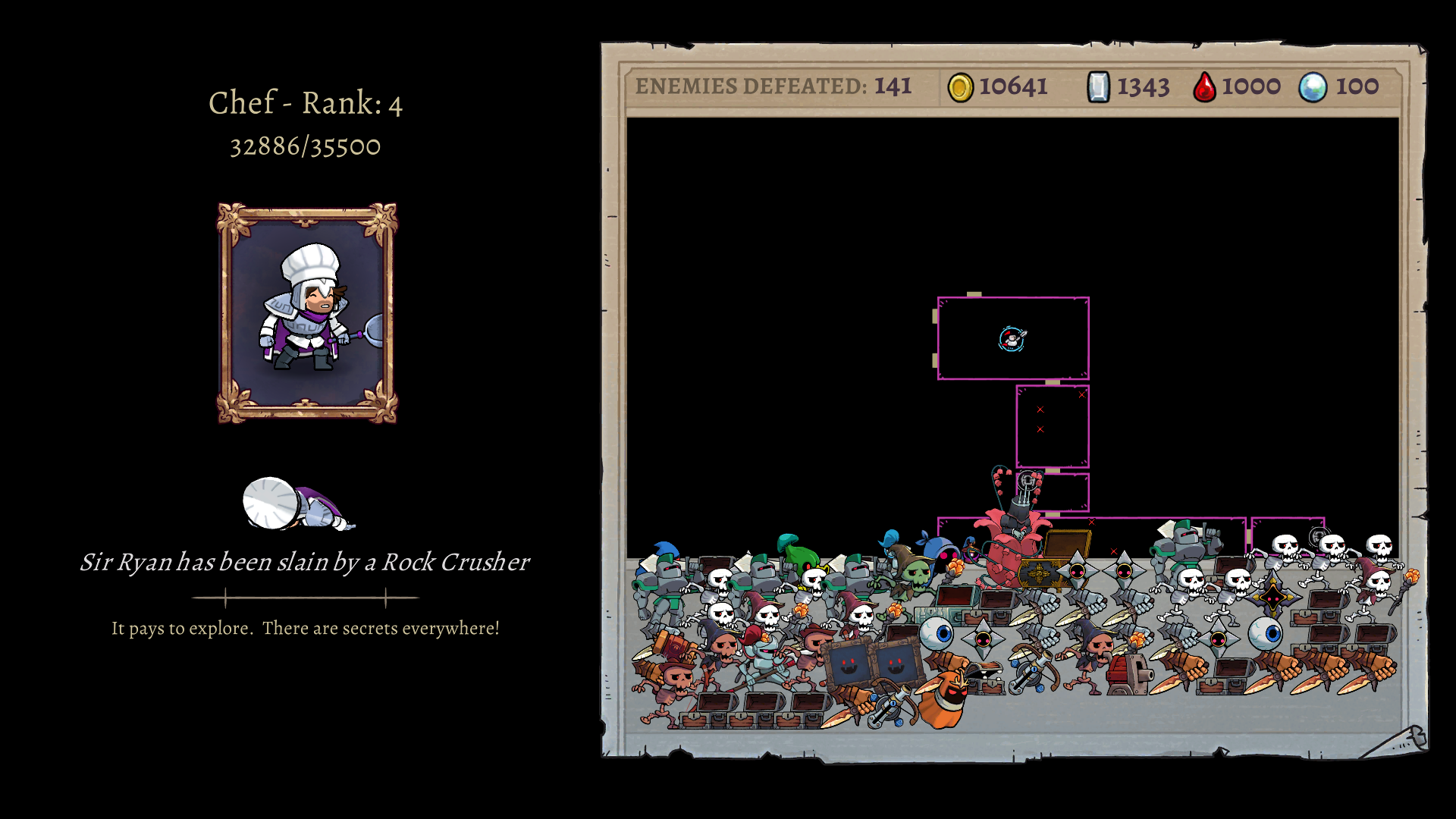Laptop Mag Verdict
Rogue Legacy 2 expands on its predecessor in almost every way. However, it’s difficult to make lightning strike twice when the roguelite genre has expanded in the years since the original.
Pros
- +
The descendant system is still extremely dynamic and enjoyable
- +
Engaging narrative and world
- +
Expanded possibilities from the first game
Cons
- -
Higher skill ceiling can be frustrating
- -
Less charisma in descendant system
- -
The large amount of systems can at times be overwhelming
Why you can trust Laptop Mag
My 60th heir to enter the castle is a chef named Sir Ryan. He has squinting eyes, brown hair and a 5 o'clock shadow. He cooks and can summon lightning. He goes to the Kerguelen Plateau, a barren land of snow made from ash, to fight one of the estuaries, the one whom his ancestors spent the last 10 generations preparing to fight. Everything he fights he is too terrified to even look at, for he never trained in a real-world scenario. He trained in the monastery, with no knowledge of the real world. It was all so horrifying he couldn’t even bear to distinguish one enemy from another.
He doesn't know why he entered the castle, and neither did his parents. They go because they always have and always will. Along the way, his cooking isn't enough, and he eats the rotten apple over the ripe one, to bolster himself for the coming battle. He finally reaches her throne, and prepares his cooking materials. It's going to be a long fight, and he will have to maintain his energy. The estuary blooms from her flower amidst the ash and the battle ensues. She summons jellyfish and flames to kill Ryan, but Ryan jumps off of them. And if he is hit too much, he takes a moment to eat. Ryan sets her aflame and with a final kick she falls into ash. But Ryan does not see, for he feels fear. Later Ryan is found dead in Citadel Agartha, killed by a lowly eyeball minion.
This is one story of nearly 100 different characters I played throughout my time in Rogue Legacy 2, the sequel to the 2013 roguelite platformer created by Cellar Door Games. For the past year I have followed Rogue Legacy 2’s development, as the original Rogue Legacy was a notable moment when games and my relationship to them changed. The original Rogue Legacy was a moment when PC gaming was starting to become feasible again, not in a big rig way, but in a way where anyone with a cheap laptop could download a 2D game on Steam to play. It was also a time in the early 2010’s when roguelites were still exploring their identity. The Binding of Isaac and Spelunky remake had only been released within the past two years, and the genre was still in its infancy.
It’s in this nostalgia for the early 2010’s that Rogue Legacy sits within me, and that provoked excitement upon hearing that a sequel was coming. The original game was foundational in the genre as a roguelite implementing ideas from action platformers like Castlevania. It also was one of the first roguelites that didn’t force players to win with palm-sweating skill. The descendant traits and castle leveling system opened up the possibility for any player to win just by getting to a point where a character became powerful enough.
Considering this, the big question is how does a seminal title like Rogue Legacy evolve into a sequel? In Rogue Legacy 2’s case, it attempts to expand. But is that enough to rank on our best PC games page?
Embracing the process
In Rogue Legacy 2, the consequences of a player’s decisions will trickle throughout each run; which person will be your heir? At the most immediate glance, this decision asks the player to decide which weapon, play style, abilities, and traits they prefer and seem most interesting to see play out. This is one of Rogue Legacy 2’s strongest aspects, as the number of combinations possible with each heir you choose is outlandish to the point that I couldn’t even estimate a number. In my time playing, there wasn’t a single character I saw that had a repeated build.
What’s fun about these characters is not just the sheer amount of options the game gives you, but the drastically different ways that they play. Rogue Legacy 2 handles these choices well by staggering the options the player has across the length of the game. A new game will start with characters who all have swords or a similar physical weapon. However, by the end of the game there are weapons which completely break the player’s understanding of what was possible in terms of combat and traversal.
Sign up to receive The Snapshot, a free special dispatch from Laptop Mag, in your inbox.
These moments are some of Rogue Legacy 2’s strongest, as they are designed to let the player break the game. After spending 25 hours struggling against a challenging series of platforming or a new group of enemies, it is one of the most cathartic moments to roll a character with an ability that easily passes by them. It’s also cool to just discover characters that have new ways of interfacing with the world, even if they aren’t overly powerful. Going from a standard sword bearer to someone who relies on full aerial combos or unique melee combinations is an enjoyable change up.
The choice of these characters also have effects that trickle further than just changing the way your character plays. Choosing a character in Rogue Legacy 2 also means choosing what goal you want a run to focus on. For instance, choosing a character whose traits are set up to be more powerful will be great to charge against the boss. However, sometimes there are characters who are not so powerful, but instead bring in extra money or experience points you can invest in your future characters. Rogue Legacy 2 offers the player a choice: Do you want to invest or do you want to fight?
Comparing the original to the sequel
Almost everything above could be said about the first game as well. Rogue Legacy 2 doesn’t attempt to diverge from its predecessor as much as it aims to recreate the game for the modern era. This means that general descriptions and functions of the game remain the same, but the scope of the games greatly vary. In some ways this improves on the original, but other aspects are lost. Rather than considering this worse than the original, it’s more beneficial to consider what the game is prioritizing for the sake of that loss.
Rogue Legacy 2 is a game that is clearly building off of the legacy of the original, and considering it was a game coming from early access, it’s clear that fans have had a say in what elements are prioritized over others. If there was a word to describe the sequel, it would be “expansion.” Every element from the first game has been expanded tenfold. From the amount of combinations and systems the player has to navigate to the styles of gameplay implemented throughout the castle’s sheer size.
In the original Rogue Legacy, a lot of the game was scaled down in comparison because it was emphasizing how unique the foundational elements of the game were. This meant a lot of the emphasis was put on the descendant system, its randomized dungeons, and pixelated evocation of its inspirations. Rogue Legacy was fairly concise in these regards, too. There were 5 bosses and the different areas between each boss didn’t require a large amount of time to progress. The descendant system had a lot of cool ideas but didn’t expand out to a massive degree. Rogue Legacy also had the charm of being the first title for the series, the developers, and showcasing the genre. There were things that were a little awkward, but they were charismatic because they were experimenting.
If the first Rogue Legacy was a concise full meal, Rogue Legacy 2 feels like a week of meals. Rogue Legacy has expanded every one of the previous elements to not only create longevity, but a larger depth of play. A very clear example of this is the change in difficulty. Rogue Legacy 1 was a game that was difficult, but it was nothing that couldn’t be traversed if your character was leveled. Rogue Legacy 2, however, implements much higher level platforming areas and enemy attack patterns that at times may make one question their own ability. I would estimate the amount of time and the skill ceiling required to get through Rogue Legacy 1 is equivalent to getting through two full areas in Rogue Legacy 2.
All of these iterations on the original games’ formula make sense considering the evolution of the genre since the release of the original. Games like Dead Cells, Noita, and Skul: The Hero Slayer have built on the foundations Rogue Legacy left behind but many of them have emphasized difficulty to a much larger degree than Rogue Legacy. The difficulty of Rogue Legacy was also one of the game’s most polarizing aspects. Many loved how refreshing the design of allowing players to complete the game purely on character growth and randomized elements. However, there were also many who found it less satisfying that the game required you to grow a certain amount before you could progress. In Rogue Legacy 2, it’s clear which side the developers have decided to appeal to. For me it’s a bit disappointing considering how distinct the arc of growth felt in the original game, but it doesn’t necessarily drag the sequel down as much as homogenize it.
There are elements lost from the first game’s charm as well. The music isn’t as jaunty and thrilling as the original game, but rather it’s more subtle and sits in the background of each world. It’s still good music, it just doesn’t stand out. The descendant system, while expanded in terms of character class and abilities, also has lost some of the flavor text that made the characters so appealing in the original. There are still a large amount of traits that can characterize your heirs in Rogue Legacy 2, but they focus on how a character plays rather than building who your characters are.
At first I was disappointed these elements weren’t in the game. The original Rogue Legacy really emphasized its descendant system, and even if some traits were just for flavor, they characterized each heir distinctly. Losing those elements is palpable in the game’s charisma, and in the heir system. However, the more I think about losing these elements, I think about what Rogue Legacy 2 trades off.
A broken world
Perhaps we need not think of a sequel exclusively as an expansion to the original, as much as an adaptation. This can’t be used as a blanket statement, some sequels are, in fact, updated versions of the original game. However, if a sequel is built from the ground up, it is based on the original title, and in making it the developers choose which aspects to retain and which to remove.
In Rogue Legacy 2, the standout aspect is the narrative and world space. Coming into the second game, I fully expected to feel indifferent about the narrative that the world has to offer. In the original title, the text never really grabbed me and instead just felt like a flavor for players who wanted to engage further with the world. However, the text in Rogue Legacy 2 presents a world after it has been broken. The books and souls that lie in the crevices tell stories of individuals who tried to make change, who tried to protect others and the world around them but have failed. As a result, many of them lost sight of their goals and even themselves to achieve this goal.
These narratives only make up a small portion of playing the game, but they color the world your heirs traverse. A snowy mountainous area becomes a realization that you stand on an ashen graveyard that was once a garden. A stormy dock is slowly revealed as the site of an attempted coup. These areas already feel more characterized than the first game in their visual design, but I found myself thrilled that the text in the game offered the opportunity to further their depth.
Bottom line
Rogue Legacy 2 is a thoroughly expanded sequel to the original 2013 roguelite. However, amidst all this change, it’s hard to feel the same glimmer of awe that the first game struck. We are living in a time where the roguelite genre has expanded greatly, and because of this, doubling down and expanding the original game isn’t enough to make lightning strike twice.
This being said, Rogue Legacy 2 isn’t a bad game by any means. It’s still incredibly fun to run through with multiple heirs aiming to grind through the entire castle. Rogue Legacy 2 lets me do that with even more options and possibilities than before. However, the height of emotion that was created by the first game may ever lie in the cave of our nostalgia, lying right next to the aims of its sequel.




